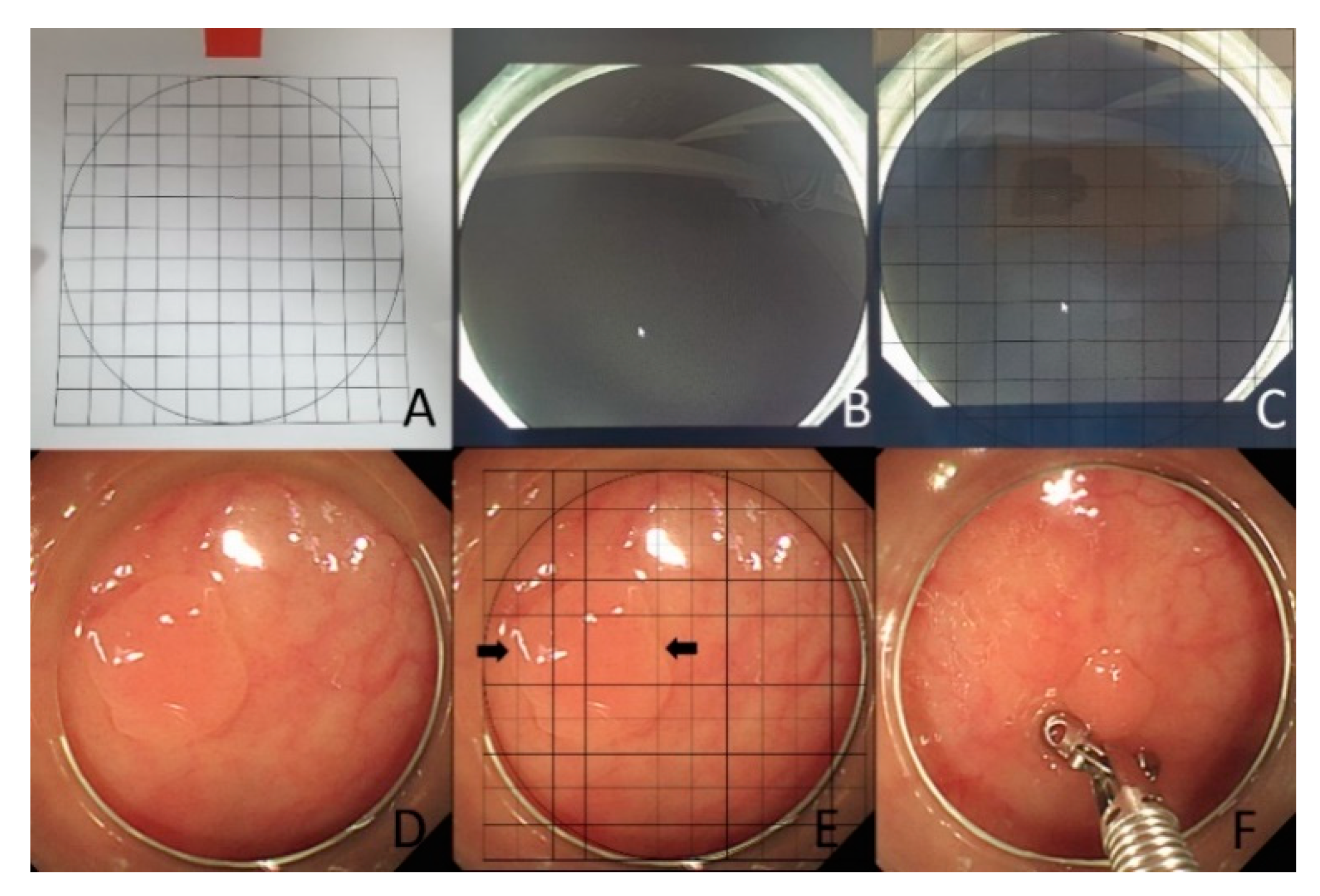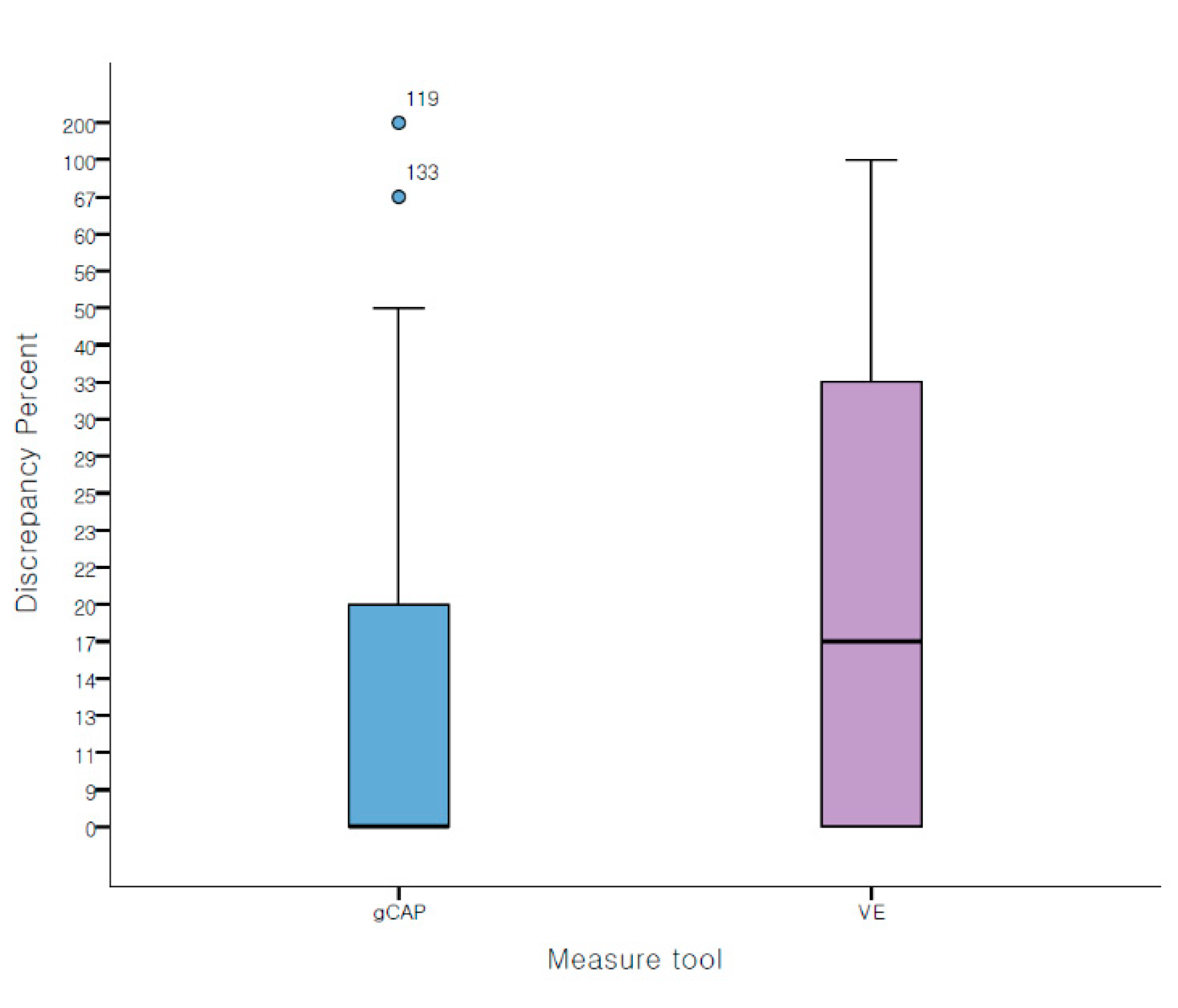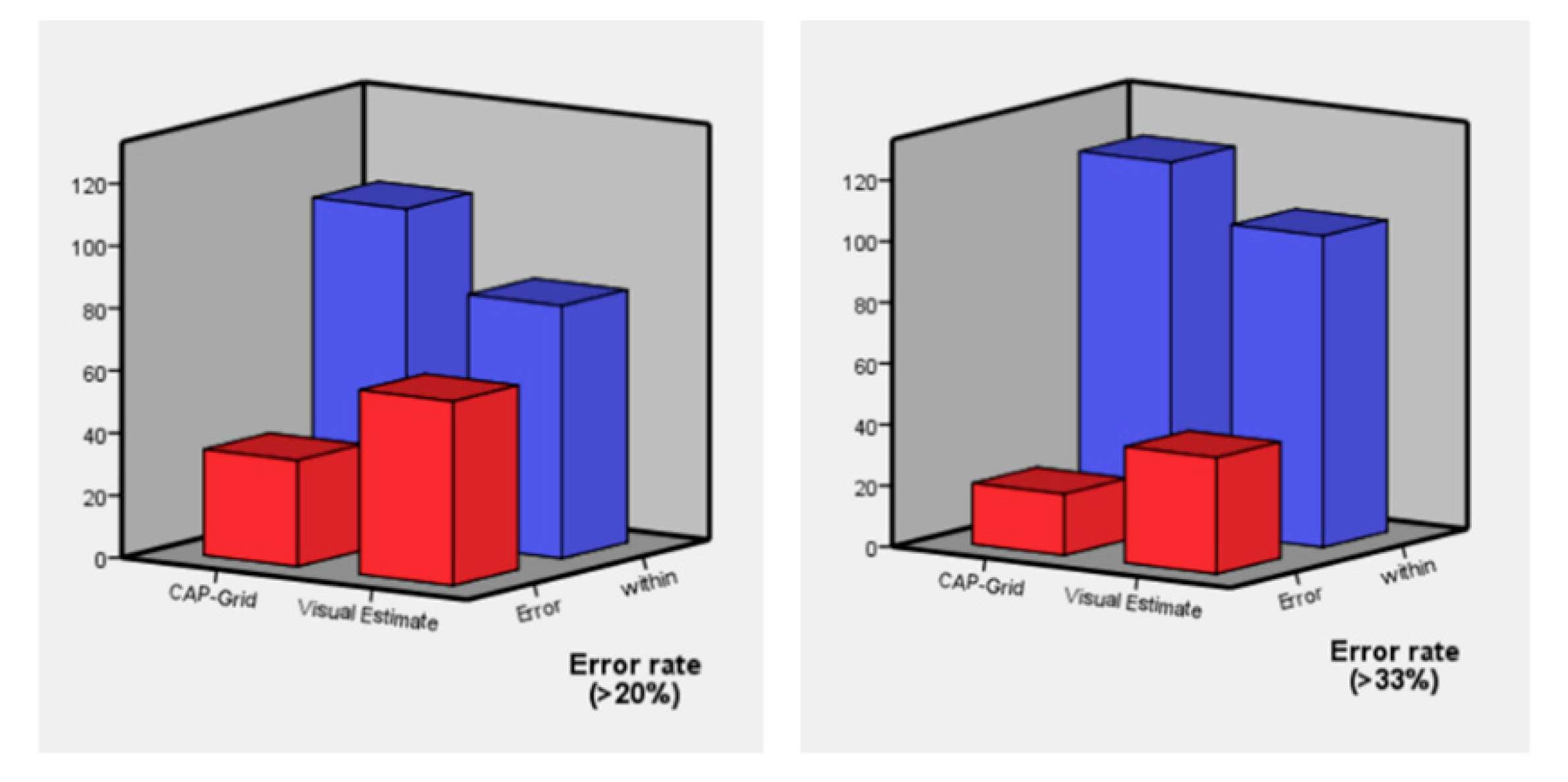Usefulness of a Colonoscopy Cap with an External Grid for the Measurement of Small-Sized Colorectal Polyps: A Prospective Randomized Trial
Abstract
1. Introduction
2. Materials and Methods
2.1. Subjects and Randomization
2.2. Procedures and Intervention
2.3. Outcomes and Definitions
2.4. Statistical Analysis
3. Results
3.1. Mean Polyp Size, DP, and ER
3.2. Subgroup Analysis
3.3. Time Taken for Polyp Size Measurement
4. Discussion
Author Contributions
Funding
Institutional Review Board Statement
Informed Consent Statement
Data Availability Statement
Acknowledgments
Conflicts of Interest
References
- Sakata, S.; Klein, K.; Stevenson, A.R.L.; Hewett, D.G. Measurement bias of polyp size at colonoscopy. Dis. Colon Rectum 2017, 60, 987–991. [Google Scholar] [CrossRef]
- Eichenseer, P.J.; Dhanekula, R.; Jakate, S.; Mobarhan, S.; Melson, J.E. Endoscopic mis-sizing of polyps changes colorectal cancer surveillance recommendations. Dis. Colon Rectum 2013, 56, 315–321. [Google Scholar] [CrossRef]
- Hassan, C.; Repici, A.; Rex, D.K. Addressing bias in polyp size measurement. Endoscopy 2016, 48, 881–883. [Google Scholar] [CrossRef]
- Ferlitsch, M.; Moss, A.; Hassan, C.; Bhandari, P.; Dumonceau, J.M.; Paspatis, G.; Jover, R.; Langner, C.; Bronzwaer, M.; Nalankilli, K.; et al. Colorectal polypectomy and endoscopic mucosal resection (EMR): European Society of Gastrointestinal Endoscopy (ESGE) clinical guideline. Endoscopy 2017, 49, 270–297. [Google Scholar] [CrossRef] [PubMed]
- Shaw, M.J.; Shaukat, A. Does polyp size scatter matter? Gastrointest. Endosc. 2016, 83, 209–211. [Google Scholar] [CrossRef] [PubMed]
- Tang, L.D.; Di Re, A.; El-Khoury, T. Accuracy of estimation of polyp size at colonoscopy. ANZ J. Surg. 2020, 90, 1125–1129. [Google Scholar] [CrossRef] [PubMed]
- Utsumi, T.; Horimatsu, T.; Seno, H. Measurement bias of colorectal polyp size: Analysis of the Japan Endoscopy Database. Dig. Endosc. 2019, 31, 589. [Google Scholar] [CrossRef]
- Chaptini, L.; Chaaya, A.; Depalma, F.; Hunter, K.; Peikin, S.; Laine, L. Variation in polyp size estimation among endoscopists and impact on surveillance intervals. Gastrointest. Endosc. 2014, 80, 652–659. [Google Scholar] [CrossRef]
- Kaz, A.M.; Anwar, A.; O’Neill, D.R.; Dominitz, J.A. Use of a novel polyp “ruler snare” improves estimation of colon polyp size. Gastrointest. Endosc. 2016, 83, 812–816. [Google Scholar] [CrossRef] [PubMed]
- Leng, Q.; Jin, H.Y. Measurement system that improves the accuracy of polyp size determined at colonoscopy. World J. Gastroenterol. 2015, 21, 2178–2182. [Google Scholar] [CrossRef]
- Jin, H.Y.; Leng, Q. Use of disposable graduated biopsy forceps improves accuracy of polyp size measurements during endoscopy. World J. Gastroenterol. 2015, 21, 623–628. [Google Scholar] [CrossRef]
- Watanabe, T.; Kume, K.; Yoshikawa, I.; Harada, M. Usefulness of a novel calibrated hood to determine indications for colon polypectomy: Visual estimation of polyp size is not accurate. Int. J. Colorectal Dis. 2015, 30, 933–938. [Google Scholar] [CrossRef] [PubMed]
- Mir, F.A.; Boumitri, C.; Ashraf, I.; Matteson-Kome, M.L.; Nguyen, D.L.; Puli, S.R.; Bechtold, M.L. Cap-assisted colonoscopy versus standard colonoscopy: Is the cap beneficial? A meta-analysis of randomized controlled trials. Ann. Gastroenterol. 2017, 30, 640–648. [Google Scholar] [CrossRef]
- Kim, D.J.; Kim, H.W.; Park, S.B.; Kang, D.H.; Choi, C.W.; Hong, J.B.; Ji, B.H.; Lee, C.S. Efficacy of cap-assisted colonoscopy according to lesion location and endoscopist training level. World J. Gastroenterol. 2015, 21, 6261–6270. [Google Scholar] [CrossRef]
- Rex, D.K.; Rabinovitz, R. Variable interpretation of polyp size by using open forceps by experienced colonoscopists. Gastrointest. Endosc. 2014, 79, 402–407. [Google Scholar] [CrossRef]
- Kim, J.H.; Park, S.J.; Lee, J.H.; Kim, T.O.; Kim, H.J.; Kim, H.W.; Lee, S.H.; Baek, D.H.; Bigs, B.U. Is than visualization for measurement of colon polyp size? World J. Gastroenterol. 2016, 22, 3220–3226. [Google Scholar] [CrossRef]
- Riner, M.A.; Rankin, R.A.; Guild, R.T., 3rd; Kastens, D.J. Accuracy of estimation of colon polyp size. Gastrointest. Endosc. 1988, 34, 284. [Google Scholar] [CrossRef]
- Murino, A.; Hassan, C.; Repici, A. The diminutive colon polyp: Biopsy, snare, leave alone? Curr. Opin. Gastroenterol. 2016, 32, 38–43. [Google Scholar] [CrossRef]
- Anderson, B.W.; Smyrk, T.C.; Anderson, K.S.; Mahoney, D.W.; Devens, M.E.; Sweetser, S.R.; Kisiel, J.B.; Ahlquist, D.A. Endoscopic overestimation of colorectal polyp size. Gastrointest. Endosc. 2016, 83, 201–208. [Google Scholar] [CrossRef] [PubMed]
- Schoen, R.E.; Gerber, L.D.; Margulies, C. The pathologic measurement of polyp size is preferable to the endoscopic estimate. Gastrointest. Endosc. 1997, 46, 492–496. [Google Scholar] [CrossRef]
- Buijs, M.M.; Steele, R.J.C.; Buch, N.; Kolbro, T.; Zimmermann-Nielsen, E.; Kobaek-Larsen, M.; Baatrup, G. Reproducibility and accuracy of visual estimation of polyp size in large colorectal polyps. Acta Oncol. 2019, 58, S37–S41. [Google Scholar] [CrossRef] [PubMed]
- Visentini-Scarzanella, M.; Kawasaki, H.; Furukawa, R.; Bonino, M.A.; Arolfo, S.; Lo Secco, G.; Arezzo, A.; Menciassi, A.; Dario, P.; Ciuti, G. A for gastrointestinal polyp size measurement: A preliminary comparative study. Endosc. Int. Open 2018, 6, E602–E609. [Google Scholar] [PubMed]
- Shaukat, A.; Shamsi, N.; Menk, J.; Church, T.R.; Rank, J.; Colton, J.B. Polyp but not adenoma detection rates by endoscopists in a large community practice. Clin. Gastroenterol. Hepatol. 2019, 17, 2034–2041. [Google Scholar] [CrossRef]
- Chang, C.Y.; Chiu, H.M.; Wang, H.P.; Lee, C.T.; Tai, J.J.; Tu, C.H.; Tai, C.M.; Chiang, T.H.; Huang, J.K.; Chang, D.C.; et al. An endoscopic training model to improve accuracy of colonic polyp size measurement. Int. J. Colorectal Dis. 2010, 25, 655–660. [Google Scholar] [CrossRef] [PubMed]
- Utsumi, T.; Horimatsu, T.; Nishikawa, Y.; Teramoto, A.; Hirata, D.; Iwatate, M.; Sano, Y.; Seno, H. Short educational video to improve the accuracy of colorectal polyp size estimation: Multicenter prospective study. Dig. Endosc. 2020, 32, 1074–1081. [Google Scholar] [CrossRef]






| gCAP (n = 56) | VE (n = 55) | p Value | |
|---|---|---|---|
| Age | 63.7 ± 8.5 | 63.8 ± 10.9 | 0.971 |
| Male sex | 71.4% (40/56) | 50.9% (28/55) | 0.027 |
| Abdominal surgical history | 12.5% (7/56) | 16.4% (9/55) | 0.562 |
| Stomach | 5.5% (3/56) | 0% (0/55) | |
| Colon | 3.5% (2/56) | 7.3% (4/55) | |
| Gynecology | 3.5% (2/56) | 9.1% (5/55) | |
| Adequate bowel preparation | 91.1% (51/56) | 90.0% (50/55) | 0.976 |
| Sedation | 66.1% (37/56) | 92.7% (51/55) | 0.001 |
| Cecal intubation time (sec) | 363 ± 235 | 382 ± 215 | 0.664 |
| Withdrawal time (sec) | 652 ± 292 | 733 ± 403 | 0.227 |
| Total number of polyps | 2.9 ± 3.1 | 3.4 ± 2.6 | 0.389 |
| gCAP (n = 140) | VE (n = 140) | p Value | |
|---|---|---|---|
| Mean size using VE or gCAP | 4.0 ± 1.7 mm | 4.2 ± 1.7 mm | 0.368 |
| Mean size by forceps | 4.0 ± 1.7 mm | 4.5 ± 2.2 mm | 0.329 |
| DP * (%) | 13.0 ± 22.0 | 18.5 ± 19.7 | 0.029 |
| ER with 20% criteria (%, n) | 24.3% (34/140) | 42.1% (59/140) | 0.002 |
| ER with 33% criteria (%, n) | 14.3% (20/140) | 27.1% (38/140) | 0.008 |
| Overcall rate (%, n) | 11.4% (16/140) | 15.7% (22/140) | 0.295 |
| Undercall rate (%, n) | 12.9% (18/140) | 26.4% (37/140) | 0.004 |
| Subgroup Analysis | |||
|---|---|---|---|
| 1–4 mm | gCAP (n = 96) | VE (n = 85) | p value |
| DP (%) | 12.9 ± 15.5 | 14.2 ± 16.1 | 0.554 |
| ER with 20% criteria (%, n) | 27.1% (26/96) | 37.6% (32/85) | 0.129 |
| ER with 33% criteria (%, n) | 17.7% (17/96) | 27.1% (62/85) | 0.130 |
| ≥5 mm | gCAP (n = 44) | VE (n = 55) | p value |
| DP (%) | 13.4 ± 32.1 | 25.0 ± 22.8 | 0.037 |
| ER with 20% criteria (%, n) | 18.2% (8/44) | 49.1% (27/55) | 0.001 |
| ER with 33% criteria (%, n) | 6.8% (3/44) | 27.3% (15/55) | 0.009 * |
Publisher’s Note: MDPI stays neutral with regard to jurisdictional claims in published maps and institutional affiliations. |
© 2021 by the authors. Licensee MDPI, Basel, Switzerland. This article is an open access article distributed under the terms and conditions of the Creative Commons Attribution (CC BY) license (https://creativecommons.org/licenses/by/4.0/).
Share and Cite
Han, S.-K.; Kim, H.; Kim, J.-w.; Kim, H.-S.; Kim, S.-Y.; Park, H.-J. Usefulness of a Colonoscopy Cap with an External Grid for the Measurement of Small-Sized Colorectal Polyps: A Prospective Randomized Trial. J. Clin. Med. 2021, 10, 2365. https://doi.org/10.3390/jcm10112365
Han S-K, Kim H, Kim J-w, Kim H-S, Kim S-Y, Park H-J. Usefulness of a Colonoscopy Cap with an External Grid for the Measurement of Small-Sized Colorectal Polyps: A Prospective Randomized Trial. Journal of Clinical Medicine. 2021; 10(11):2365. https://doi.org/10.3390/jcm10112365
Chicago/Turabian StyleHan, Seul-Ki, Hyunil Kim, Jin-woo Kim, Hyun-Soo Kim, Su-Young Kim, and Hong-Jun Park. 2021. "Usefulness of a Colonoscopy Cap with an External Grid for the Measurement of Small-Sized Colorectal Polyps: A Prospective Randomized Trial" Journal of Clinical Medicine 10, no. 11: 2365. https://doi.org/10.3390/jcm10112365
APA StyleHan, S.-K., Kim, H., Kim, J.-w., Kim, H.-S., Kim, S.-Y., & Park, H.-J. (2021). Usefulness of a Colonoscopy Cap with an External Grid for the Measurement of Small-Sized Colorectal Polyps: A Prospective Randomized Trial. Journal of Clinical Medicine, 10(11), 2365. https://doi.org/10.3390/jcm10112365






